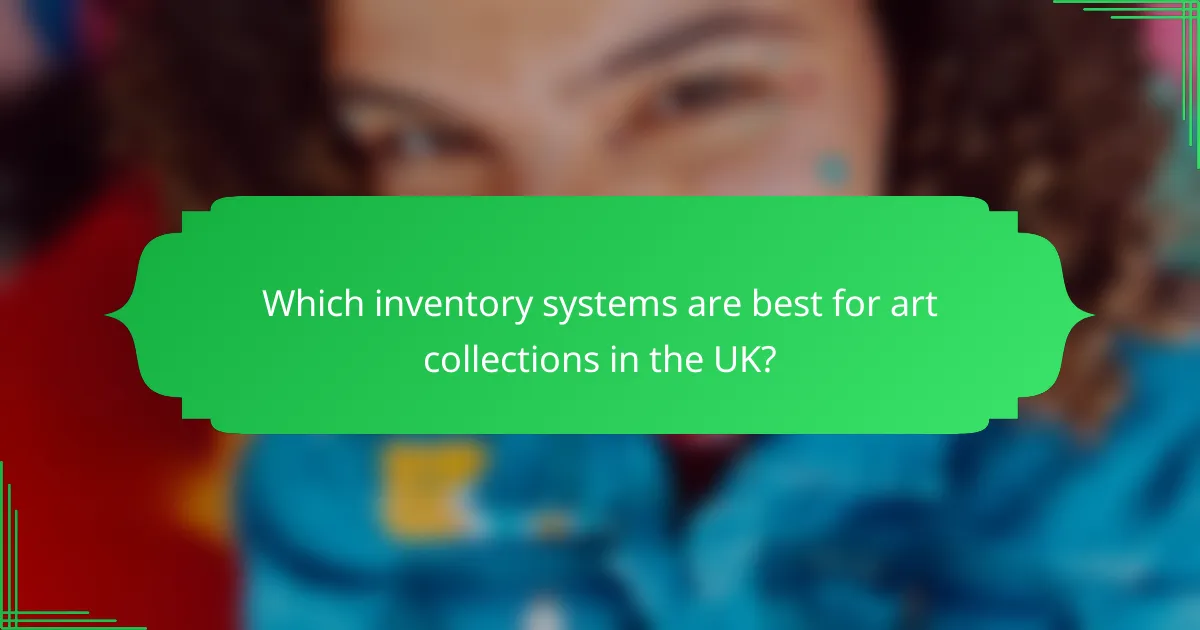Cataloging artworks requires effective documentation methods, such as digital photography and written descriptions, to maintain accurate records and facilitate management. Implementing robust inventory systems tailored to the needs of galleries, museums, and collectors is essential for compliance and ease of use. Additionally, tracking tools enhance artwork management by streamlining processes and ensuring precise monitoring of location, condition, and provenance.

What are effective documentation methods for cataloging artworks?
Effective documentation methods for cataloging artworks include digital photography, written descriptions, condition reports, provenance records, and artist statements. These methods help ensure accurate records and facilitate the management and valuation of artworks.
Digital photography
Digital photography is a crucial method for cataloging artworks, providing a visual record that captures details and colors accurately. High-resolution images should be taken from multiple angles to document the artwork’s condition and features.
When photographing, use consistent lighting and backgrounds to maintain uniformity across your catalog. Consider using a tripod for stability and to avoid blurriness, ensuring that images are clear and professional.
Written descriptions
Written descriptions complement visual documentation by providing essential details about each artwork, such as title, dimensions, medium, and date of creation. These descriptions should be concise yet informative, allowing for easy reference.
Include any notable features or techniques used in the artwork, and consider using a standardized format to maintain consistency across your catalog. This practice helps in quickly identifying and comparing artworks.
Condition reports
Condition reports are vital for assessing the physical state of an artwork, detailing any damage, deterioration, or necessary repairs. These reports should be created at the time of acquisition and updated regularly, especially before and after exhibitions.
Include specific observations about the artwork’s surface, frame, and any signs of wear. A thorough condition report can aid in conservation efforts and inform potential buyers about the artwork’s status.
Provenance records
Provenance records trace the ownership history of an artwork, providing context and authenticity. Documenting previous owners, exhibitions, and sales helps establish the artwork’s value and legitimacy.
Maintain detailed records of any certificates of authenticity, gallery exhibitions, and auction results. This information is crucial for collectors and institutions when assessing the significance and market value of the artwork.
Artist statements
Artist statements offer insights into the artist’s intent, techniques, and themes within their work. Including these statements in your catalog can enhance understanding and appreciation of the artwork.
Encourage artists to articulate their creative process and motivations clearly. This documentation can be valuable for galleries and collectors, providing a deeper connection to the artwork and its creator.

Which inventory systems are best for art collections in the UK?
For art collections in the UK, effective inventory systems should provide robust documentation, easy tracking, and user-friendly interfaces. The best systems cater to the specific needs of galleries, museums, and private collectors, ensuring compliance with local regulations and standards.
Artlogic
Artlogic is a popular choice for galleries and artists, offering a comprehensive suite of tools for managing collections. It provides features such as inventory tracking, client management, and online sales integration. Users appreciate its intuitive interface and customizable options, making it suitable for various types of art collections.
Consider Artlogic if you need a cloud-based solution that allows access from anywhere. Pricing typically starts at a moderate monthly fee, which can vary based on the features selected.
CollectiveAccess
CollectiveAccess is an open-source software designed for managing and sharing collections. It is highly customizable, allowing institutions to tailor the system to their specific needs. This flexibility makes it ideal for larger organizations or those with unique requirements.
While CollectiveAccess offers powerful features, it may require more technical expertise to set up and maintain. Institutions should weigh the benefits of customization against the potential need for IT support.
PastPerfect
PastPerfect is a widely used inventory system for museums and historical societies, known for its comprehensive cataloging features. It supports a range of documentation methods, including images and detailed descriptions, making it suitable for diverse collections.
With a one-time purchase fee, PastPerfect can be cost-effective for smaller organizations. However, users should be aware that updates and support may incur additional costs over time.
Gallery Systems
Gallery Systems offers a range of products tailored for art galleries and museums, focusing on collection management and exhibition planning. Their software is designed to streamline workflows and enhance collaboration among staff members.
When considering Gallery Systems, evaluate the specific features that align with your institution’s needs. Pricing can vary significantly based on the size of the collection and the number of users, so it’s advisable to request a demo to assess its fit for your organization.
![]()
How can tracking tools enhance artwork management?
Tracking tools significantly improve artwork management by streamlining inventory processes and ensuring accurate documentation. These tools help in monitoring the location, condition, and provenance of artworks, making it easier to manage collections effectively.
Barcode scanning
Barcode scanning is a straightforward method for tracking artworks, utilizing unique barcodes assigned to each piece. By scanning these codes with a handheld device, users can quickly access information such as the artwork’s title, artist, and location within a collection.
This method is cost-effective and easy to implement, requiring minimal training for staff. However, it relies on a physical barcode being intact and visible, which can be a drawback for some artworks.
RFID technology
RFID (Radio Frequency Identification) technology offers a more advanced tracking solution by using radio waves to identify and track items. Each artwork is embedded with an RFID tag, allowing for automatic scanning without direct line-of-sight, which is beneficial for larger collections.
While RFID systems can be more expensive to set up compared to barcode systems, they provide enhanced tracking capabilities, such as real-time inventory updates and improved security. This technology is particularly useful in environments where artworks are frequently moved or displayed.
Mobile apps
Mobile apps designed for artwork management allow users to track and document pieces directly from their smartphones or tablets. These apps often include features like inventory management, condition reporting, and even integration with barcode or RFID systems.
Using mobile apps can enhance accessibility and convenience, enabling staff to update records on-the-go. However, it is essential to choose apps that offer robust security features to protect sensitive information about the collection.
Cloud-based solutions
Cloud-based solutions provide a centralized platform for managing artwork documentation and inventory. These systems allow multiple users to access and update information from anywhere, facilitating collaboration among staff members.
Cloud solutions typically offer scalability and automatic updates, which can be beneficial for growing collections. However, organizations should ensure they have reliable internet access and consider data security measures to protect their valuable information.

What criteria should be considered when selecting an inventory system?
When selecting an inventory system for cataloging artworks, consider factors such as scalability, user-friendliness, integration capabilities, and cost. These criteria will help ensure that the system meets both current and future needs while remaining accessible and efficient.
Scalability
Scalability refers to the system’s ability to grow alongside your collection. A good inventory system should accommodate an increasing number of artworks without a significant drop in performance or requiring a complete overhaul.
For example, if you start with a few dozen pieces and anticipate expanding to hundreds or thousands, choose a system that can handle this growth seamlessly. Look for features like cloud storage or modular upgrades that allow for easy scaling.
User-friendliness
User-friendliness is crucial for ensuring that all team members can effectively use the inventory system. A straightforward interface with intuitive navigation can significantly reduce training time and improve overall efficiency.
Consider systems that offer customizable dashboards and easy data entry options. A trial period or demo can help assess how user-friendly a system is before committing to it.
Integration capabilities
Integration capabilities determine how well the inventory system can work with other tools and software you may already be using. A system that easily integrates with existing platforms, such as accounting software or digital asset management tools, can streamline operations.
Check for compatibility with popular software solutions and ensure that the system supports data import/export functions to facilitate smooth transitions and updates.
Cost
Cost is a significant factor when selecting an inventory system, as it encompasses not just the initial purchase price but also ongoing maintenance and potential upgrade fees. Assess your budget and consider both upfront and long-term costs.
Many systems offer tiered pricing based on features or the number of users, so evaluate which features are essential for your needs. Look for systems that provide clear pricing structures and avoid hidden fees to ensure you stay within budget.

What are the common challenges in cataloging artworks?
Cataloging artworks involves several challenges, primarily related to data accuracy and resource allocation. These issues can hinder effective inventory management and tracking of art pieces, making it essential to address them systematically.
Data accuracy
Ensuring data accuracy is crucial in cataloging artworks, as incorrect information can lead to misidentification and valuation errors. Art institutions should implement standardized data entry protocols and regular audits to maintain high-quality records.
Utilizing digital cataloging systems with validation features can help minimize human error. For instance, using dropdown menus for artist names or artwork types can streamline data entry and reduce inconsistencies.
Resource allocation
Resource allocation refers to the effective distribution of time, personnel, and budget for cataloging artworks. Many organizations struggle with limited staff and funding, which can impede the cataloging process and lead to incomplete records.
To optimize resource allocation, institutions should prioritize their cataloging efforts based on the value and significance of the artworks. Creating a phased approach can help manage workloads and ensure that critical pieces are documented first.